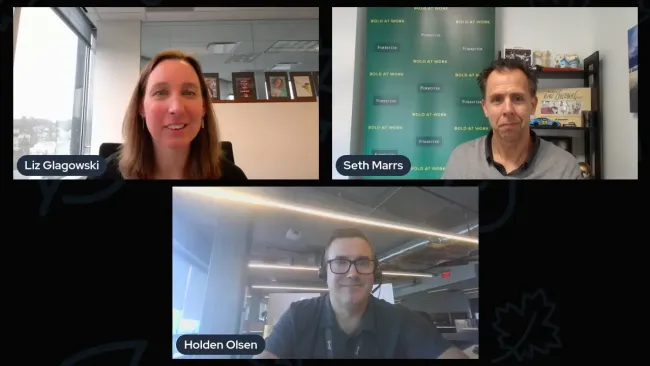Think you know your customers? Think again. New research from TeleTech Consulting shows that business buyers of all sorts are asking salespeople to do more, listen more, find out more, and be more disciplined in their approach. Yet sales professionals have not kept pace with customer expectations and have yet to take bold enough steps to transform their sales functions to be more relationship-focused.
Every three years we conduct global research into What It Takes to Win Business based on the perspectives of 178 global buyers and sales professionals from a range of industry sectors. The 2015 findings show a shift in buyer expectations from previous years. Respondents listed four top attributes that had the most positive impact on their buying decisions: credibility, knowledge, listening skills, and ability to communicate value. In addition, they expect sales professionals to be genuinely curious about their business and to be more courageous by challenging them with knowledge relevant to them.
Common sense, not common practice
The bar has been raised when it comes to winning business. Much of what customers are asking for is good old-fashioned common sense, which is not often common practice. Sales teams are not evolving at the rate the market demands. In particular, the research highlights four takeaways for sales organizations:
- The death of formulaic questioning
- Discipline is the new black
- Courage and curiosity to shift thinking
- The real cost of discounting
Insight #1: The death of formulaic questioning
Compared to our global findings in 2012, there have been a number of significant changes in buyer expectations. It is now evident that the thought of being ‘sold to’ or participating in an obvious, contrived sales dialogue is not an experience buyers enjoy or even respect. The research highlighted a spiked difference between the value customers place on ‘listening’ as opposed to ‘questioning’ (see Figure 1). This reinforces the importance of great conversation skills throughout the customer engagement lifecycle. Customers clearly want a conversation, not an interrogation.
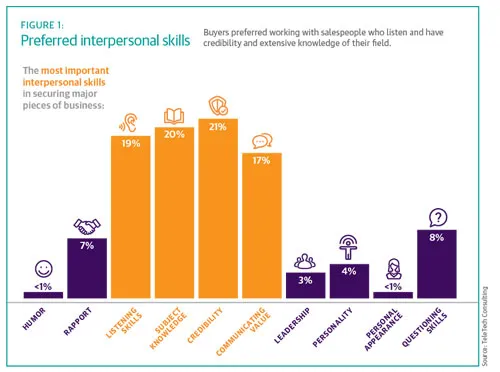
Good research that identifies topics of conversation, combined with genuine listening, is the ‘mining equipment’ salespeople need to subtly, naturally, and effectively ‘drill down’ in order to understand customers better than anyone else. The ability to gather key nuggets of information and turn them into relevant insights makes the pitch for business much more effective.
Asking questions in a relaxed and authentic manner, rather than in an overly structured and formulaic way, is a fine balance of art and science. Great salespeople will always have a set of carefully crafted questions that demonstrate understanding and prompt insight. And they will have the ability to truly listen and carefully probe—essential in today’s sophisticated selling environment.
In addition, ‘chemistry’ as a key buying criteria is up significantly, to 25 percent in 2015 compared to 13 percent in 2012 (see Figure 2). Not surprisingly, the top decision-making factor is when a buyer feels the salesperson “understands my situation.” We believe the verdict is in: formulaic questioning is dead.
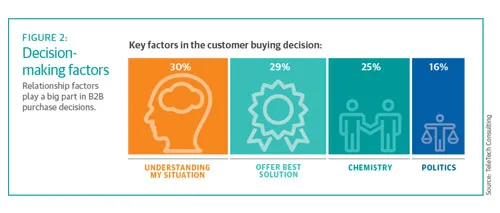
Insight #2: Discipline is the new black
Discipline is as essential to the sales process as the presentation of the solution. Without it, sales people will not measure up to the exacting standards their customers now expect. The sales process has become more sophisticated and competitive, demanding a more deliberate and focused approach. There is no room for improvization. Our research shows that credibility and understanding carry as much as 50 percent of the vote in the decision process. That requires disciplined and authentic interactions with every customer.
More than half of respondents identified that a key part of their decision-making process was based on the sales professional’s deep knowledge of the buyer’s industry, business drivers and needs (see Figure 3). Each interaction needs to be considered and prepared—but not scripted, because the buyer will be continuously assessing your credibility and ability to bring value.
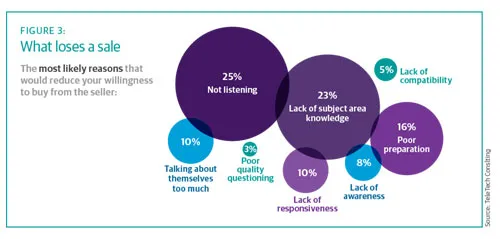
Being a “one-hit wonder” may win you the business, but discipline, courage, and curiosity will help you keep it. Purchasing and procurement officers tell us that complacency of the incumbent is the single biggest reason why they look for alternatives and issue new tenders. This means that we cannot risk improvization at any point in our relationship with the B2B customer. Understanding their needs is the most critical aspect of winning business (see Figure 4).
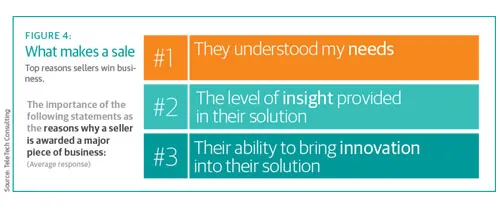
Insight #3: Courage and curiosity to shift thinking
The 2015 research findings indicate that 75 percent of buying decisions relate to how well you communicate your knowledge, understanding, and value.
Buyers are drowning in information and thirsting for knowledge and value. In this environment, it is essential that sales professionals have the ability to provoke new thinking and buying behaviors. Much has been written and discussed in recent years about the need to transform sales teams from a solution-selling approach to an insight-led approach. As the science of this approach has evolved, there is more evidence to suggest that the discussion is insight-led and brought to life by a crucial ingredient—the ability to tell a great story. While some people are natural storytellers, this is an art form that often needs to be developed in terms of how sales professionals communicate both verbally and in writing.
This is a challenge and opportunity for sales professionals today. Even the most experienced buyer can have outdated beliefs and buying behaviors based on previous situations, advice, or experiences which may not be relevant in today’s marketplace. The rapid pace of technology, social change, communication, and globalization means that many buyers are still taking a 2005 approach to solve a 2015 problem. This can be frustrating for some sales professionals who then resort to a ‘velvet sledgehammer’ approach, drowning the customer in rational arguments, facts, and figures, hoping to convince them to adopt new buying behaviors. Smart sales professionals take a much more subtle and creative approach to help buyers upgrade their thinking and update their approach to solving problems.
This involves striking the right balance of curiosity and courage. Curiosity comes in the form of disciplined research and preparation, combined with clever, insightful questions that truly make customers think and consider new possibilities. Curiosity really pays off when the knowledge gained about the buyer is leveraged to tell a compelling story. The story must have a strong point or lesson for the buyer, or it is unlikely to create a strong case for change.
Great stories, not cut and paste presentations. With a growing emphasis on written submissions in the sales process, applying cut and paste from your company template is not enough to get you through to the final stages in the decision-making process (see Figure 5). Often the written document is all the person reading the proposal has to form a perception of you, your business, and your brand. If your document leaves them thinking: “So what,” then the point of your story is missing and you are unlikely to find yourself in the winner’s circle.
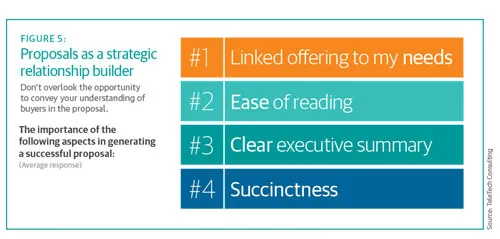
Insight #4: The real cost of discounting
Today’s demanding and informed buyer knows that the asking price is usually the starting point. Our research shows that over the last decade, price has risen as a key selection criteria from ninth position to occupy second place in the rankings (see Figure 6).
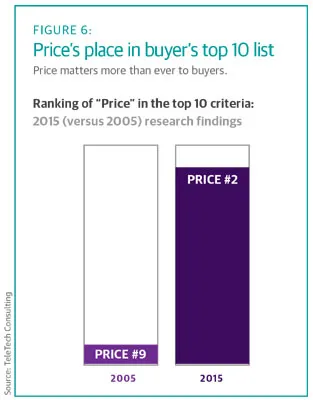
Given the expectations of today’s buyers, sales professionals need a new level of confidence and capability to develop intimate knowledge. This ensures they understand the commercial and emotional drivers early on in the buying cycle. While some of this relates to the conversation skills required to avoid recreating an interrogation scene, there are some fundamental operating guidelines and frameworks that organizations can deploy to arm their team for price conversations.
As a simple measure, companies can give their sales teams a better understanding of the real cost of discounting. Depending on the margin of the sale, even a discount of 5 percent across the board means you may need to sell at least 20 percent more volume to make up the difference. When we ask salespeople if they believe they can increase sales by 20 percent as a result of a 5 percent discount, most get pretty uncomfortable. This simple education process works wonders. As an added measure, we sometimes see companies effectively linking remuneration and bonuses more closely to gross margin or profit, rather than pure volume.
Businesses need to arm their sales teams with the strategies, messages, and skills to “get the price exactly right.” Salespeople need to know that discounts cost money and ultimately it’s up to them to hold the line—and it helps if they’re incentivized to do it.
Like the savvy retail shop owner who knows her customers intimately and achieves the ‘buy it now with assurances’ price, the best B2B salespeople understand and act on the basis that most buyers will pay at least a small premium to suppliers who provide convenience, peace of mind, added value, and mitigated risk for their business. The best price is not necessarily the right price.
Conclusion
The research in the 2015 Global Report on What It Takes to Win Business indicates that winning is not about doing one thing 100 percent better; it is about lifting performance in a selected number of key areas and applying them consistently, with discipline. Placing your B2B buyer at the center of your sales approach and helping them make a stronger emotional and rational connection with your brand and your sales solution will win you more business.





